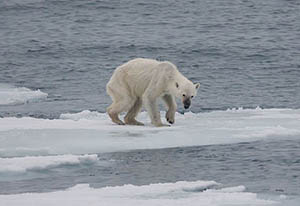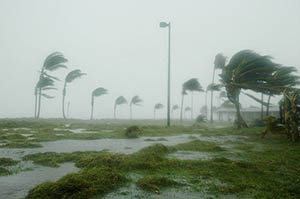Climate change: dreadful consequences worldwide
 At the same time, torrential rains devastated Europe and Asia, while hurricanes of high intensity periodically hit the coasts of the United States, ...
At the same time, torrential rains devastated Europe and Asia, while hurricanes of high intensity periodically hit the coasts of the United States, ...
Over the last 50 years, the number of disasters of meteorological, climatic or hydrological origin has increased five times.
According to Swiss Re's analyses, climate deregulation is becoming the number one risk for insurers and reinsurers in the long run.
Climate change: rising temperatures and sea levels
In 2020, the average global temperature has increased by 1.2 °C compared to the pre-industrial era. This global warming is having a lasting effect on weather patterns and ecosystems. The consequences on the planet are already irreversible for centuries or even millennia, UN climate experts warn.
The latest report of the Intergovernmental Panel on Climate Change (IPCC), published in early August 2021, reveals that global temperatures should, according to the least pessimistic scenario, increase by 1.5 °C by 2030. The IPCC's previous estimate, made three years ago, predicted such a rise of 1.5 °C in 2040 and not in 2030, that is, ten years later.
Today, the most pessimistic scenario foresees a warming of between 3.3 and 5.7 degrees if governments do not review their environmental policies.
The biggest risks are the melting of ice and the rise of water levels. Indeed, the level of the oceans has risen by nearly 20 cm since 1900.
In the last 10 years, the rate of rise of the waters has tripled. At this pace, the sea level could rise by up to one meter by 2100 and by up to two meters according to most downbeat scenarios.
Climate change: extremely intense natural disasters
The other consequence of climate change consists of extreme weather events such as hurricanes, storms, fires, heat waves, etc. which are becoming more frequent and intense in many parts of the world.
These risks are 1.2 to 9 times higher than those sustained during the pre-industrial era.
Hurricanes, a recurrent phenomenon in the United States
 High intensity hurricanes continue to occur one after the other in the United States. After Andrew with 53 billion USD of economic losses in 1992, Katrina (163 billion USD) in 2005, Sandy (75 billion USD) in 2012, Harvey (135 billion USD), Maria (100 billion USD) and Irma (55 billion USD) in 2017, Ida came to compound the losses by hitting the south and north-east of the country at the end of August-beginning of September 2021. The states of Louisiana, New Jersey and New York were also devastated.
High intensity hurricanes continue to occur one after the other in the United States. After Andrew with 53 billion USD of economic losses in 1992, Katrina (163 billion USD) in 2005, Sandy (75 billion USD) in 2012, Harvey (135 billion USD), Maria (100 billion USD) and Irma (55 billion USD) in 2017, Ida came to compound the losses by hitting the south and north-east of the country at the end of August-beginning of September 2021. The states of Louisiana, New Jersey and New York were also devastated.
Ida has claimed the lives of at least 50 people and caused material damage estimated, to date, at 95 billion USD.
In 2020, the North Atlantic reported a record 29 tropical storms. At the end of the first half of the hurricane season, which runs from 1 June to 30 November, 2021, 12 events have already been reported while the seasonal peak has not yet been reached.
Floods in Europe and Asia
Western Europe is not safe from major catastrophic events that have increased nine times compared to the pre-industrial era: severe storms, torrential rains, floods.
The floods of July 2021 affected several countries of the continent, mainly Germany and Belgium. This rainy episode, which largely exceeded the record rainfall levels reported in the past, have claimed the lives of 200 people and caused insured losses of about 8 billion USD.
In Asia, the tragic floods that occurred during the last monsoon season caused 192 deaths in Mumbai (India), 99 in China and 113 in Afghanistan.
On a global level, 920 people lost their lives during the month of July 2021 alone due to floods.
Forest fires
Forest fires are increasing around the world, often caused by unprecedented heat waves. In the summer of 2021, fires of historic proportions devastated Turkey, Greece, Italy, Canada and Algeria.
The American west coast was, on a yearly basis the hardest hit, sustaining the second largest fire in its history.
Unprecedentedly, Siberia, one of the coldest regions on the planet, was the prey of flames during the month of August 2021. Some 17.8 million hectares of forest went up in smoke between Karelia and Lakutia. For the first time in history, the toxic smoke and ashes released by these fires reached the North Pole.
Heat waves
The summer of 2021 was marked by unprecedented heat waves throughout the world, with temperature records being broken everywhere, and with prolonged heat waves. Even the coldest regions suffocated from the rising temperatures.
Canada, for example, experienced an unprecedented heat wave with temperatures exceeding 45 °C in several cities. Seasonal normal temperatures were sometimes exceeded by 20 degrees.
Absolute temperature records were also reported in Turkey (49.1 °C), Northern Ireland, Morocco, Japan, the United States and Siberia, which experienced several days of over 39 °C.
The month of July 2021 broke all records in terms of rainfall, fires and floods. It is even considered by the National Oceanic and Atmospheric Administration (NOAA) as the hottest month ever reported by meteorologists.
According to scientists, exceptional heat waves are likely to pick up two to seven times over the next three decades if air pollution continues at this current pace. New historical temperature records are therefore to be expected in the coming years.
Unbearable climate in the Gulf countries
The Gulf countries, which usually experience stifling heat waves, are facing an unbearable climate. With climate disturbances, scientists are concerned that heat stress is increasing dangerously in several cities in the region: Dubai, Abu Dhabi, Bahrain, Kuwait City, ...
